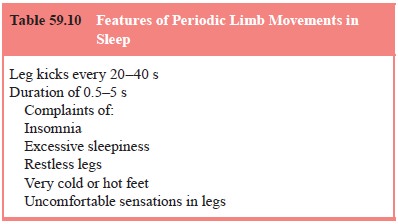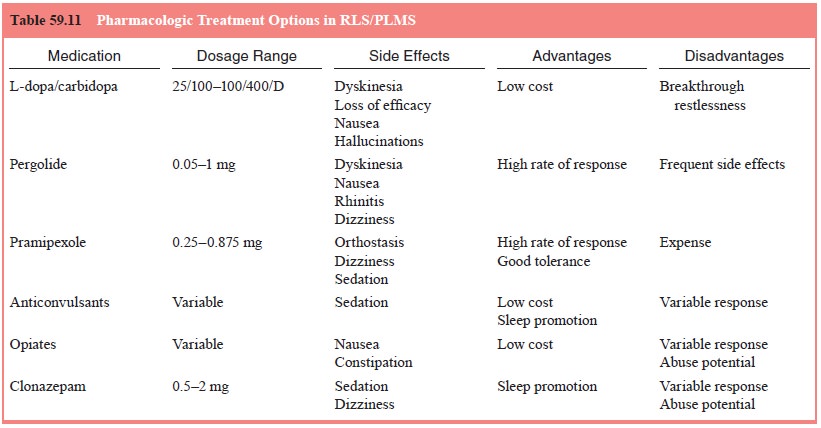Chapter: Essentials of Psychiatry: Sleep and Sleep-Wake Disorders
Periodic Limb Movements in Sleep
Periodic
Limb Movements in Sleep
Periodic
limb movements in sleep (PLMS), previously called nocturnal myoclonus, is a
disorder in which repetitive, brief and stereotyped limb movements occur during
sleep, usually about every 20 to 40 seconds. Dorsiflexions of the big toe,
ankle, knee and sometimes the hip are involved (Table 59.10)

Diagnosis
Questioning
of the patient or bed partner often yields reports of restlessness, kicking,
unusually cold or hot feet, disrupted and torn bedclothes, unrefreshing sleep,
insomnia, or excessive day-time sleepiness. Patients may be unaware of these
pathological leg movements or arousals, although their bed partners may be all
too aware of the kicking, frequent movements and restless-ness. If these
disorders are strongly suspected, the patient should probably be referred to a
sleep disorders laboratory for evaluation and an overnight polysomnogram with
tibial electromyograms. These disorders are often associated with transient
arousals in the EEG recording. Diagnosis is made when the periodic limb
movement index (number of leg jerks per hour of sleep) is five or greater,
accompanied by arousals. The jerks occur primarily in the legs but may also
appear in less severe forms in the arms. The movements can be bilateral or
unilateral and occur in stage 1 and stage 2 sleep. Patients often have reduced
deep sleep because the jerks continually awaken them.
A related disturbance, restless legs syndrome, is associ-ated with disagreeable sensations in the lower legs, feet, or thighs that occur in a recumbent or resting position and cause an almo irresistible urge to move the legs. Whereas almost all patients with restless legs syndrome have PLMS, not all patients with PLMS have restless legs syndrome. Restless legs syndrome may be frequent in patients with uremia and rheumatoid arthritis or in pregnant women. Both PLMS and restless legs syndrome usually occur in middle-aged people, but many patients report having had the same sensations as adolescents and even as children. It has been suggested that both conditions are familial, perhaps due to an autosomal dominant gene.
Individuals
with PLMS are reported to sleep about an hour less per night than control
subjects without PLMS. Inter-estingly, the prevalence of PLMS is not higher in
insomniac pa-tients than in those without insomnia. Complaints of excessive
daytime sleepiness increase in individuals with PLMS, prob-ably consequent to
the numerous sleep interruptions. The psy-chiatrist may find it useful to talk
with a bed partner, who will often describe kicking and leg twitches during
sleep in indi-viduals with PLMS. The myoclonic movements are not related to
seizure disorder but should be distinguished from seizures. Because complaints
of insomnia and daytime sleepiness are not uncommon, other insomnias, sleep
apnea and narcolepsy should be ruled out.
Prevalence
of PLMS in young and middle-aged adults has not been fully established. In
sleep disorders clinic popula-tions, about 11% of those complaining of insomnia
are diagnosed with PLMS. In the elderly, however, this condition is extremely
common; more than 45% have at least five leg kicks per hour of sleep.
Treatment
Because
the pathogenesis of PLMS is usually unknown, treat-ment is often symptomatic
(Table 59.11). Some studies suggest that the movements arise subcortically from
the brain or spinal cord; others suggest subclinical peripheral neuropathy. At
the present time, dopaminergic agents such as levodopa (L-dopa), pergolide, or
pramipexole generally provide the most effective treatment for both PLMS and
restless legs. Opiates, such as oxycodone and propoxyphene, have also been
demonstrated to be effective in the treatment of PLMS and restless legs
syn-drome. Anticonvulsants, such as carbamazepine and gabap-entin, have been shown
to be effective in treatment of restless legs syndrome. Clonazepam, a
benzodiazepine anticonvul-sant, is effective in the treatment of PLMS and
possibly for restless legs syndrome. Other benzodiazepines have also been used
to treat these conditions, as they will decrease some of the awakenings but may
have no effect on the number of leg movements.

Related Topics